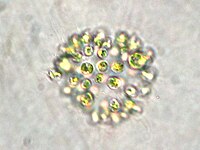
Photo from wikipedia
The toxic cyanobacterium, Microcystis, is a pervasive cyanobacterial harmful algal bloom (CHAB) - forming genus that naturally occurs in colonies that harbor diverse microbiomes of heterotrophic bacteria. While the effects… Click to show full abstract
The toxic cyanobacterium, Microcystis, is a pervasive cyanobacterial harmful algal bloom (CHAB) - forming genus that naturally occurs in colonies that harbor diverse microbiomes of heterotrophic bacteria. While the effects of nutrient loading and climatic warming on CHABs are well-known, little is known regarding how these environmental drivers alter the structural and functional potential of the microbial assemblages associated with blooms that, in turn, may impact cyanobacterial growth. Here, we used next-generation sequencing of 16S ribosomal rRNA genes to characterize the dynamics of the bacterial assemblages within Microcystis colonies in two temperate North American lakes: Lake Erie and Lake Agawam (NY, United States) and quantified their responses to experimentally increased levels of nitrogen (N), phosphorus (P) and temperature. Across experiments, Microcystis populations were consistently and significantly promoted by N and, to a lesser extent, elevated temperature (p < 0.05). In contrast, bacterial assemblages within Microcystis colonies were more resilient to environmental perturbations, with the relative abundance of 7–16% of amplicon sequence variants changing and several individual taxa displaying significant (p < 0.05) increases and decreases in relative abundance, primarily in response to elevated temperature and to a lesser extent, N. In contrast to individual taxa, community diversity was not significantly altered by individual treatments during experiments but rather was inversely correlated with the intensity of Microcystis blooms (p < 0.001). While predicted metabolic function was even less impacted by environmental drivers than microbial diversity, the predicted abundance of nitrogenase (nifH), alkaline phosphatase (phoX), and urease (ure) genes significantly increased in response to N but decreased in response to increased temperature (p < 0.05). Collectively, the resilience of microbial community structure and function within colonies suggests they may support the ability of Microcystis to persist through short-term fluctuations in environmental conditions by supplying essential nutrients.
Journal Title: Frontiers in Microbiology
Year Published: 2021
Link to full text (if available)
Share on Social Media: Sign Up to like & get
recommendations!